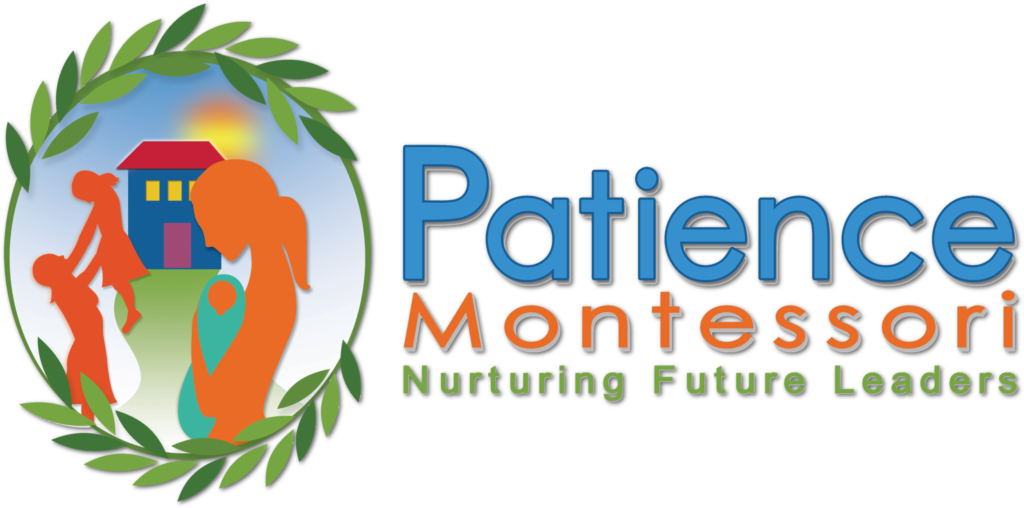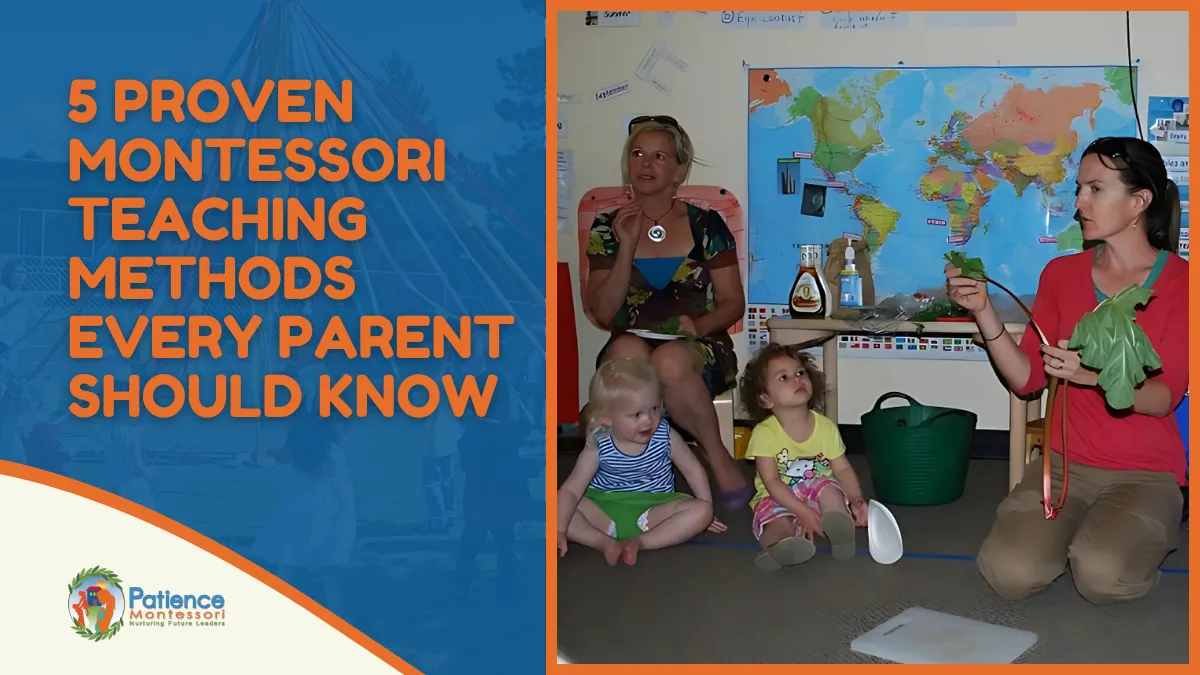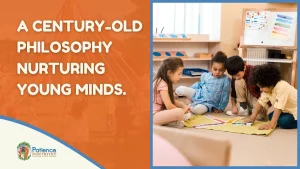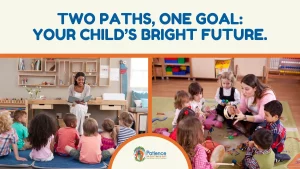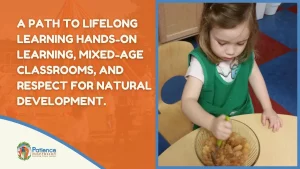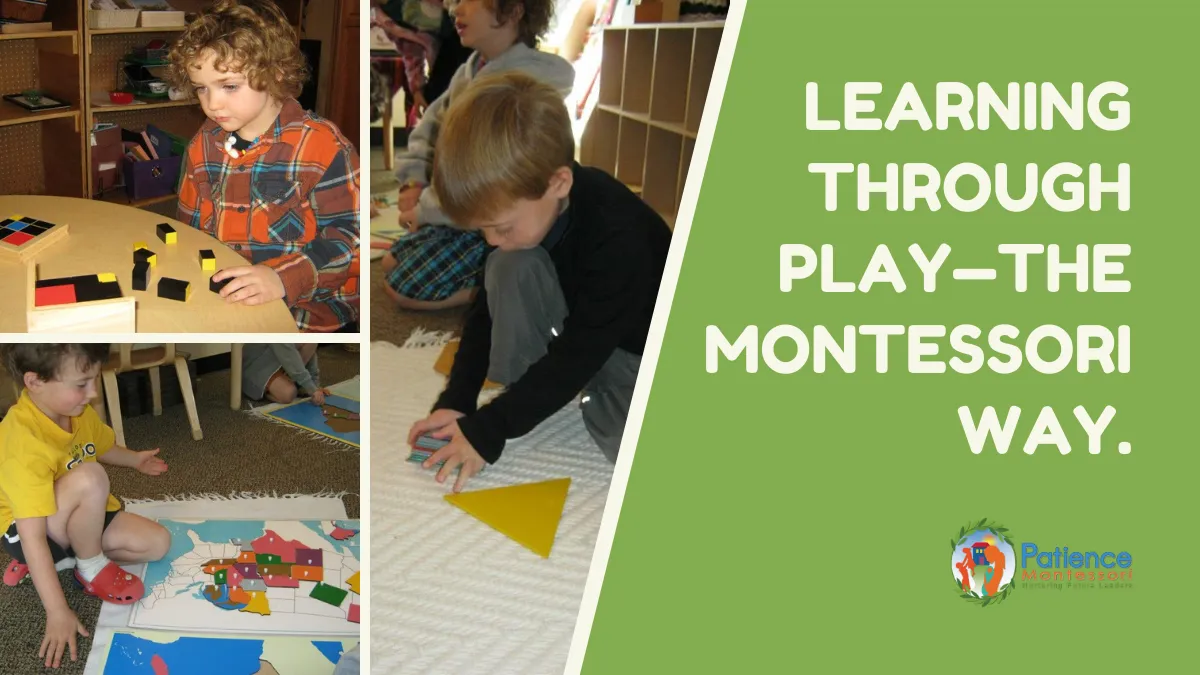
If you’re a parent exploring learning options for your little one, you’ve probably come across the term Montessori teaching methods—and for good reason. Rooted in respect, independence, and deep trust in a child’s natural development, the Montessori approach has stood the test of time for over a century. But what does that actually look like in a classroom? And more importantly, what does it feel like for a child?
At Patience Montessori, we believe every parent deserves to understand the “why” behind their child’s learning experience. So, whether you’re new to Montessori or simply curious about how it all works, let’s explore some of your questions.
What Is the Montessori Style of Teaching?
The Montessori style of teaching isn’t just a method—it’s a way of thinking that embraces your child’s unique personality and natural curiosity. Created by Dr. Maria Montessori over 100 years ago, this approach inspires kids to explore, discover, and learn at a pace that feels right for them.
Imagine a setting where children aren’t forced to follow a rigid schedule or a standard curriculum. Instead, they’re empowered to choose activities that spark their interest within a carefully prepared, orderly environment.
What sets Montessori teaching methods apart is its focus on more than just academics. It’s about fostering independence, respect, and a lifelong love of learning.
But how does this all come together? What’s the secret to creating such an inviting, child-centered experience? It’s all rooted in the Montessori method’s guiding principles. These principles shape how classrooms are designed, teachers interact with students, and children progress through their learning journeys. Let’s unpack these five essential pillars that form the heart of Montessori education.
What Are the Five Principles of the Montessori Method?
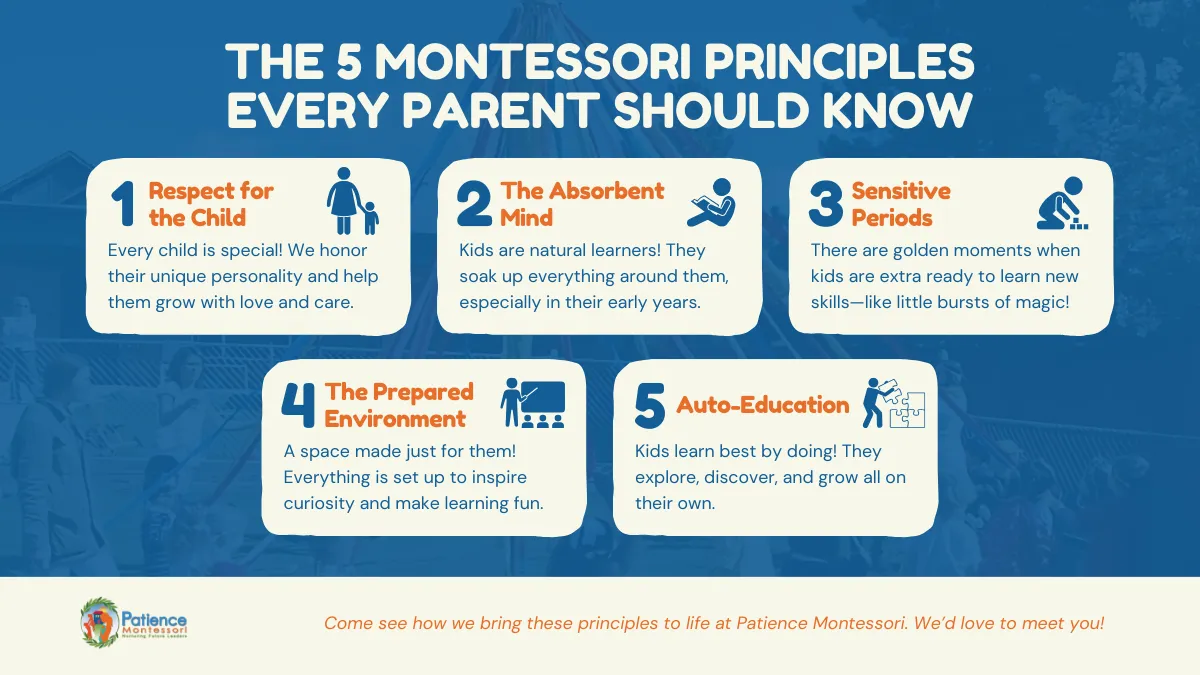
The Montessori teaching method is based on five key principles that establish a strong foundation for learning and growth in children. These principles are:
- Respect for the child – This means valuing each child as an individual, recognizing their independence, and helping them grow in a positive, supportive environment.
- The Absorbent Mind – In their early years, kids naturally soak up knowledge from the world around them as they explore and interact.
- Sensitive Periods – These are special times in a child’s development when they’re especially open to learning certain skills or concepts.
- The Prepared Environment – The environment is thoughtfully set up to encourage kids to explore on their own. Everything is easy to reach, well-organized, and designed to make learning fun and engaging.
- Auto-Education – This idea is all about kids teaching themselves through hands-on exploration. They get to work with materials at their own pace, building independence and staying motivated along the way.
What Are the 5 Areas of the Montessori Method?
Montessori education is designed to develop the whole child, and its curriculum is thoughtfully divided into five key areas. Each area plays a unique role in fostering your child’s growth, but together, they create a rich and holistic learning experience. What are these areas, and why are they so important for your child’s development? Let’s explore.
- Practical Life: Practical life activities teach children essential everyday skills like pouring, sweeping, or buttoning a shirt. These tasks may seem simple, but they build coordination, concentration, and a sense of responsibility. Imagine your child proudly setting the dinner table or folding laundry with confidence. That’s the power of practical life learning!
- Sensorial: Sensorial work helps children refine their senses and better understand the world around them. From sorting colors to exploring textures, these exercises lay the groundwork for cognitive skills like observation and analysis. Ever seen your child excitedly touch a new material or describe a smell? That’s sensorial learning in action.
- Language: Language activities nurture communication skills through reading, writing, and speaking. Children connect sounds with letters, construct words, and eventually form sentences. It’s incredible to watch as their world opens up word by word.
- Math: Montessori math transforms abstract concepts into hands-on experiences. Picture your child joyfully building a number line or counting beads to learn addition. It makes math relatable and even exciting.
- Cultural Studies: This area includes science, geography, history, and the arts, introducing kids to the bigger world. From naming continents to growing plants, cultural studies expand curiosity and respect for diverse ideas.
5 Proven Montessori Teaching Methods Every Parent Should Know
Curious about Montessori education? Learn about 5 Montessori teaching methods that help children develop independence, problem-solving skills, and a lifelong love of learning.
Child-Led Learning
One of the most defining features of the Montessori approach is child-led learning. In a Montessori classroom, children are given the freedom to choose what they want to work on, based on their interests. This fosters independence, curiosity, and a natural love of learning. The teacher’s role is to observe, guide, and provide resources, but not to direct the child’s every move.
By allowing children to take ownership of their learning, this Montessori teaching method encourages a deep connection to the material and fosters a sense of empowerment. A child who has the opportunity to choose what to study is more likely to feel excited about learning and stay engaged.
At Patience Montessori, we see this method in action when a child focuses on a puzzle for an hour or independently picks up a book to practice reading skills. It’s about encouraging their independence while providing guidance when needed.
Hands-On Exploration
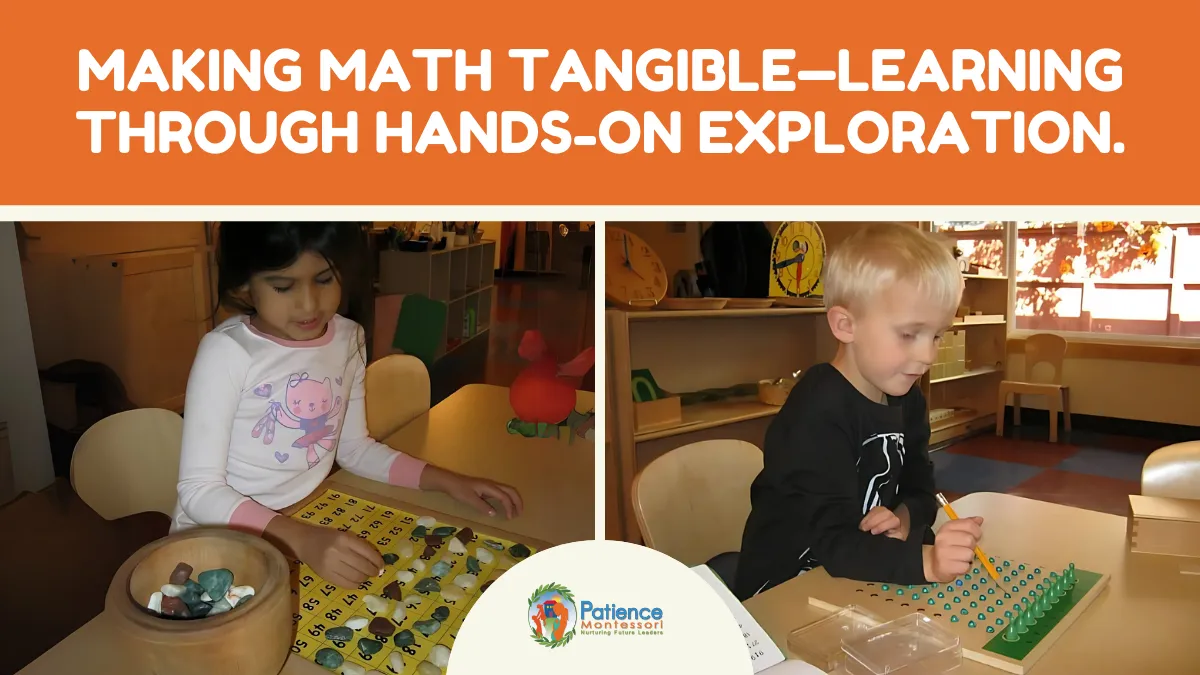
In the Montessori teaching method, hands-on learning is vital. Rather than memorizing facts from textbooks, children engage with concrete materials that allow them to learn through their senses. Whether they are building with blocks, working with colorful beads for math, or using Montessori’s specially designed language materials, every activity is designed to make abstract concepts tangible.
Hands-on exploration helps children understand the world in a way that purely theoretical learning cannot. Imagine your child discovering the concept of volume by filling different-sized containers with water or using a set of geometric solids to better understand shapes. These are not just activities but lessons in the world’s building blocks.
Multi-Age Classrooms
Montessori classrooms typically consist of children spanning a three-year age range. This multi-age setting is a key part of the method. Older children act as mentors and leaders, while younger children look up to them, which fosters empathy and cooperation. The mixed-age environment also allows children to learn at their own pace without feeling rushed or held back.
For example, a 6-year-old might help a 3-year-old understand how to use Montessori materials, reinforcing the older child’s learning while building the younger child’s skills. This dynamic creates a sense of community and camaraderie that helps everyone grow, both academically and emotionally.
Freedom within Limits
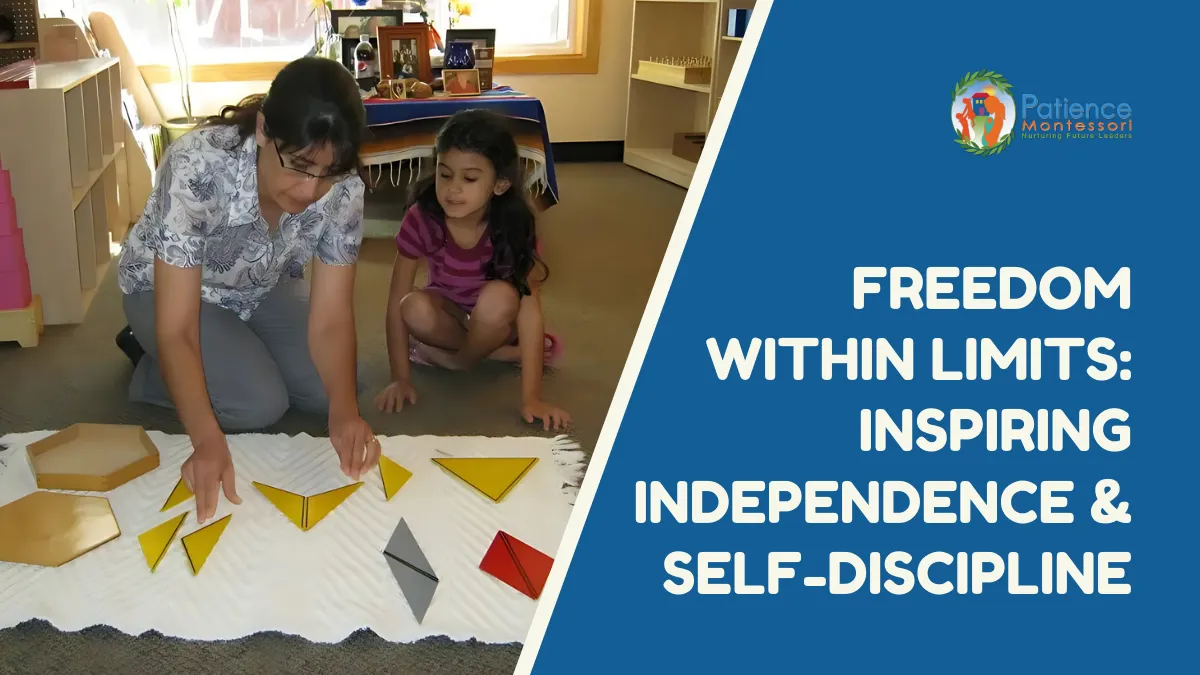
Montessori emphasizes freedom within limits, which allows children the autonomy to explore their interests but within a structured environment. This method encourages children to make their own choices while respecting rules and boundaries.
In the classroom, children may move freely from one activity to another, but they are expected to respect others and care for the materials they use. This freedom encourages self-discipline as children learn to regulate themselves and make decisions that benefit both themselves and their community.
At Patience Montessori, we support this Montessori teaching method by providing well-organized spaces where children can explore independently while maintaining a sense of order and respect for the environment and peers.
Focus on Process over Product
Montessori teaching places a strong emphasis on the process of learning rather than just the final product. Whether a child is working on an art project, writing a story, or solving a math problem, the goal is not just to complete the task—but to enjoy and learn through the process.
This method encourages growth through exploration, allowing children to make mistakes and learn from them. It also gives children the confidence to express themselves without the pressure of always achieving a perfect outcome.
For example, in our Montessori classrooms, a child may spend days building a structure with blocks or experimenting with different ways to solve a problem, learning critical thinking and problem-solving skills in the process, not just focusing on the end result.
What Is an Example of a Montessori Teaching Method?
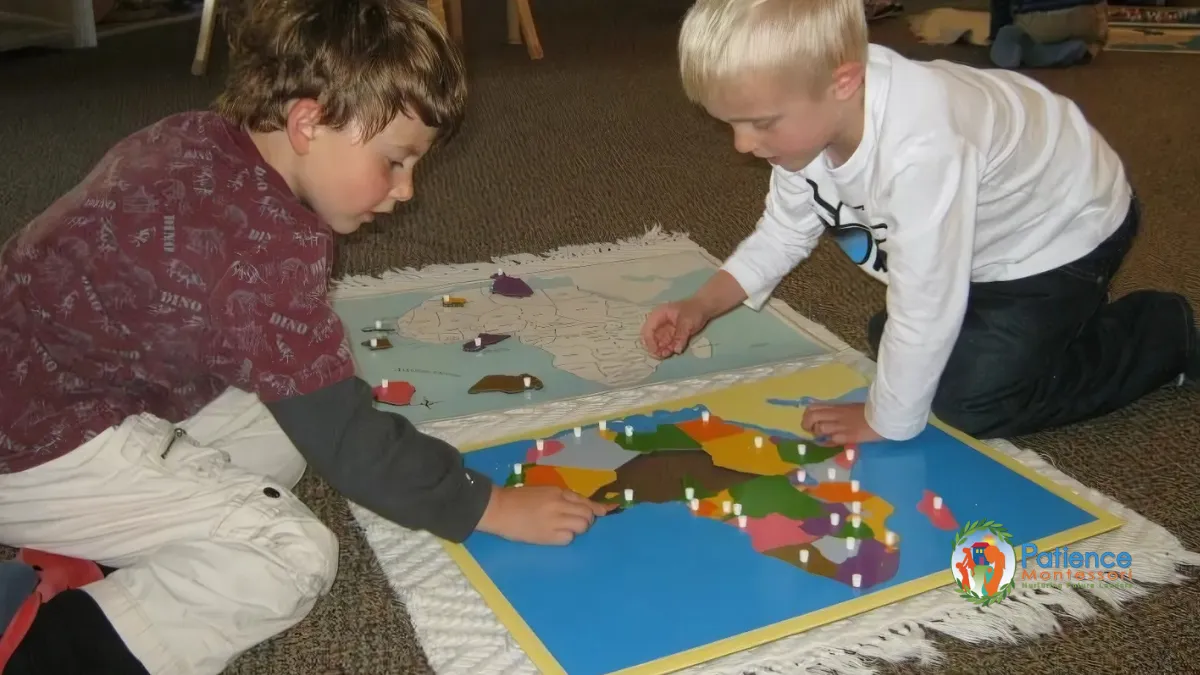
A great example of a Montessori teaching method is the use of Geometric Solids.
Geometric Solids are 3D shapes like spheres, cubes, and cones designed to help children understand spatial concepts. By manipulating these shapes, children develop an understanding of volume, shape, and structure.
Here’s how the method works:
- Building Spatial Awareness: Children handle the solids, exploring their edges and faces, which helps them understand 3D space and lays the groundwork for geometry.
- Hands-On Exploration: Montessori emphasizes kinesthetic learning. Children touch, stack, and align the solids to explore their properties, making abstract concepts tangible.
- Cognitive Development: These hands-on activities help children move from concrete understanding to more abstract thinking, fostering problem-solving and reasoning skills.
- Encouraging Discovery: The solids invite children to experiment and discover, promoting critical thinking and self-directed learning.
- Fostering Independence: Children can explore the shapes independently, supporting their autonomy and helping them learn through self-exploration.
Geometric Solids provide a tactile, engaging way for children to explore geometric concepts, build cognitive skills, and develop independence, all core principles of the Montessori method.
Common Questions About Montessori Teaching Methods
Will my child struggle with the transition to traditional schools?
Not at all! Montessori children are well-prepared for any school setting. They develop independence, critical thinking, and self-discipline, which help them adjust easily to traditional classrooms. Montessori encourages a love for learning, which benefits children in any educational environment.
How does Montessori cater to different learning styles?
Montessori is all about flexibility and adapting to your child’s unique way of learning. Whether they thrive with hands-on activities, visual tools, or listening and instructions, Montessori’s personalized approach makes sure every child gets the support they need to succeed.
What about socialization? Does Montessori foster peer interactions?
Absolutely! Montessori classrooms are multi-age, meaning children of different ages work together, share, and collaborate. This promotes social skills, empathy, and leadership as older children mentor younger ones, creating a strong sense of community.
Is Montessori only for academic learning?
Montessori focuses on developing the whole child—academic, emotional, and social growth. Beyond academics, it teaches life skills like problem-solving, self-regulation, and practical tasks (e.g., pouring, dressing) that build independence.
How does Montessori support my child’s development in the long term?
Montessori encourages self-motivation and a growth mindset, helping children build a lifelong love for learning. These skills equip them not only for school but for lifelong success in all aspects of life.
Patience Montessori: Guiding Your Child’s Path to Discovery and Success
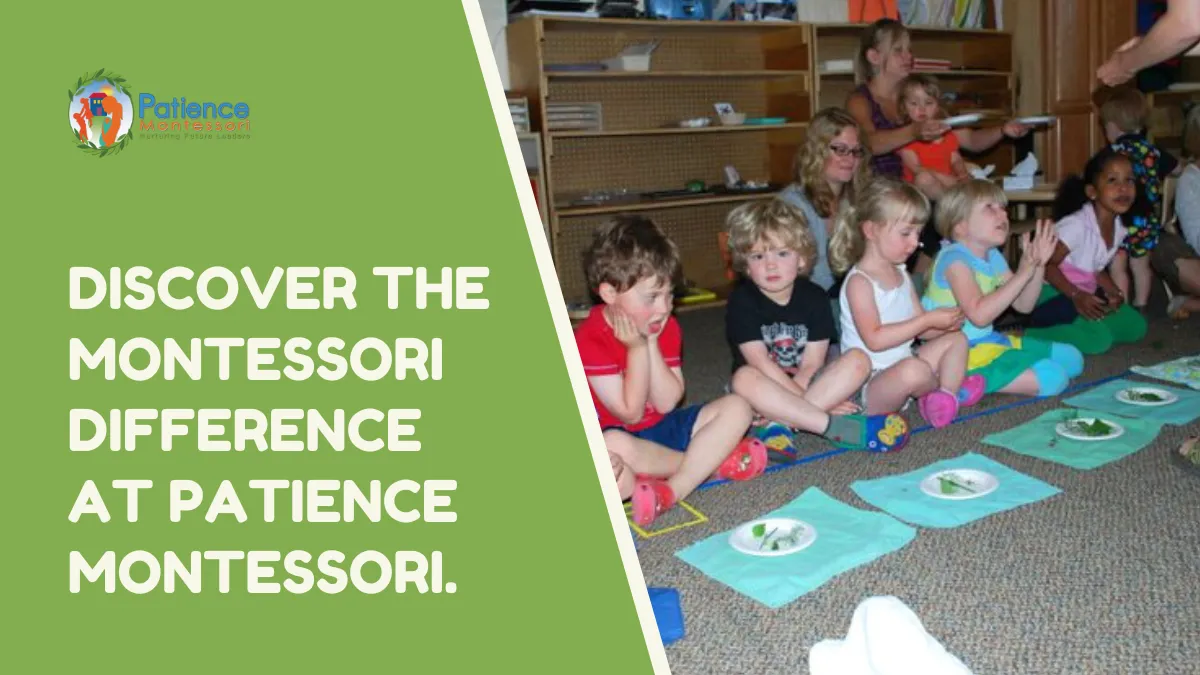
At Patience Montessori, we believe education should inspire curiosity, spark discovery, and empower children to grow at their own pace. Our approach goes beyond textbooks and rote memorization—we focus on hands-on learning, child-led exploration, and fostering independence. Every lesson, material, and activity is designed to honor your child’s unique development and ignite their natural love for learning.
With Montessori teaching, your child doesn’t just learn facts; they explore, question, and connect with the world around them. This process builds knowledge, confidence, problem-solving skills, and a resilient sense of independence. These are tools they’ll carry with them for a lifetime.
Want to see the difference for yourself? Visit Patience Montessori and experience how our proven methods help children flourish. We can’t wait to welcome you and your family into our community.
